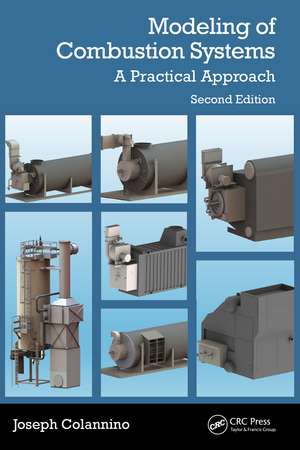Modeling of Combustion Systems: A Practical Approach
Autor Joseph Colanninoen Limba Engleză Hardback – 19 dec 2024
Retaining the emphasis on practical semiempirical modeling of boilers, process heaters, and reactors, such as ethylene cracking units and ammonia and hydrogen reformers, the second edition expands the approach to include combustion air fans and representation of complex models (direct numerical simulations or computational fluid dynamics) in concise forms. It also shows how to design experiments to collect the most data with the fewest experiments and model real unit behavior with engineering accuracy.
The book is intended for practicing process, mechanical, and plant engineers working in refining and manufacturing industries.
It includes 65 fully worked examples in Excel with detailed instructions. All example spreadsheets are available for download from the publisher’s website.
Preț: 831.24 lei
Preț vechi: 1184.79 lei
-30% Nou
Puncte Express: 1247
Preț estimativ în valută:
159.08€ • 165.87$ • 132.21£
159.08€ • 165.87$ • 132.21£
Carte nepublicată încă
Doresc să fiu notificat când acest titlu va fi disponibil:
Se trimite...
Preluare comenzi: 021 569.72.76
Specificații
ISBN-13: 9781032771236
ISBN-10: 1032771232
Pagini: 504
Ilustrații: 274
Dimensiuni: 156 x 234 mm
Greutate: 1.08 kg
Ediția:2
Editura: CRC Press
Colecția CRC Press
Locul publicării:Boca Raton, United States
ISBN-10: 1032771232
Pagini: 504
Ilustrații: 274
Dimensiuni: 156 x 234 mm
Greutate: 1.08 kg
Ediția:2
Editura: CRC Press
Colecția CRC Press
Locul publicării:Boca Raton, United States
Public țintă
Postgraduate and Professional ReferenceCuprins
1. Introduction to Combustion. 2. Thermoacoustic Resonance. 3. Combustion Calculations. 4. Heat and Work. 5. Airflow Through Burners. 6. Fuel Flow. 7. Introduction to Modeling. 8. Linear Algebra. 9. Least Squares. 10. Important Statistics and Distributions. 11. Orthogonality. 12. Factorial Designs. 13. Preventatives and Diagnostics in Experimental Designs. 14. Second-Order Designs. 15. Mixture Designs for Fuel Blends. 16. Analysis of Non-Ideal Data (Plant and Historical Data). 17. Restrictions on Randomization. 18. Flame Models. 19. Emissions Models. 20. Emissions Reduction. Appendix A. Fuel and Combustion Properties. Appendix B. Mechanical Properties. Appendix C. Units Conversions. Appendix D. Properties of the Elements. Appendix E. Statistical Tables. Appendix F. Some Useful Scales and Nomographs.
Notă biografică
Joseph Colannino earned his undergraduate degree in chemical engineering from the California Polytechnic University at Pomona (B.S.Ch.E) and his master’s degree in research management from the University of Oklahoma (MSKM, emphasis ODYN) and holds a Ph.D. in theology. With more than forty years’ experience in the combustion and fuels industries, his work includes combustion equipment of all stripes. Dr. Colannino has consulted for many industries including paper and pulp, petroleum and petrochemical, municipal solid waste-to-energy, electrical generation, and petroleum and petrochemicals plants for a wide variety of reactors and fired heaters including ethylene-cracking units, hydrogen-reforming units, and many process heaters. He pioneered or applied many novel NOx remediation strategies and holds scores of related patents on combustion equipment in revenue-producing service. Dr. Colannino is a registered professional engineer in the State of California and currently Chief Technology Officer for Faber Burner Company. He is also an accomplished musician and artist and recently published an illustrated catechetical translation of the Biblical book of Revelation from the original Greek.
Descriere
Modeling of Combustion Systems provides accessible instruction for the operator or engineer to model combustion responses such as NOx, CO, flame dimensions, heat flux, or others as a function of input factors such as excess oxygen, volumetric heat release, and fuel composition.
